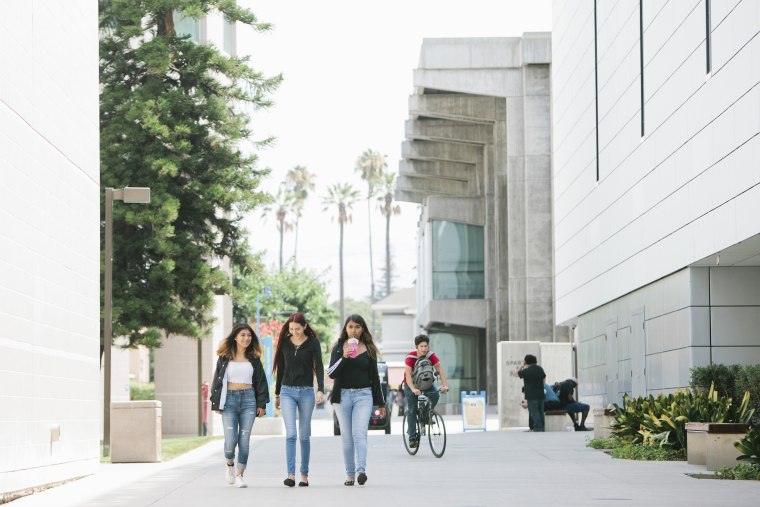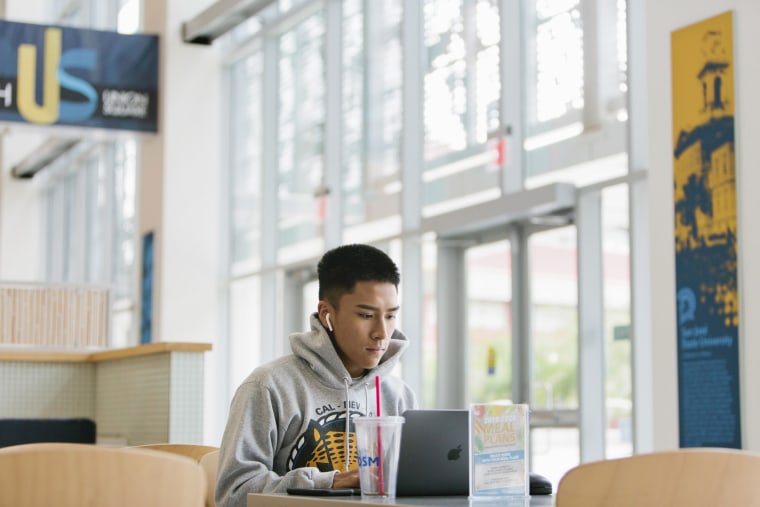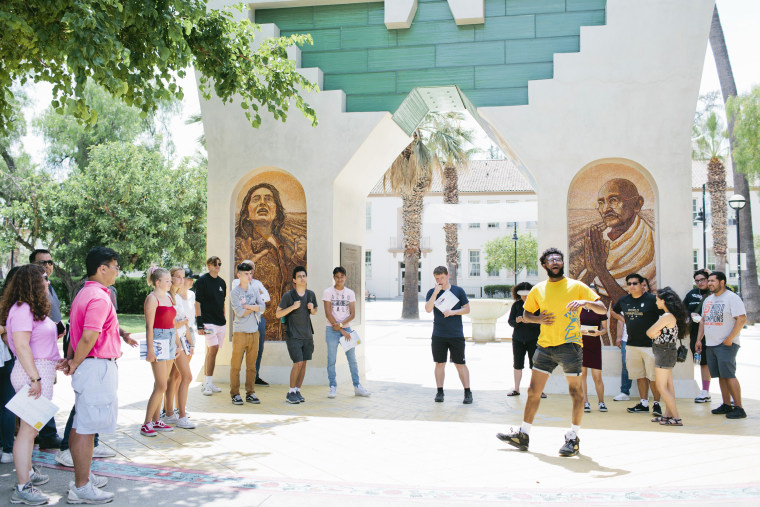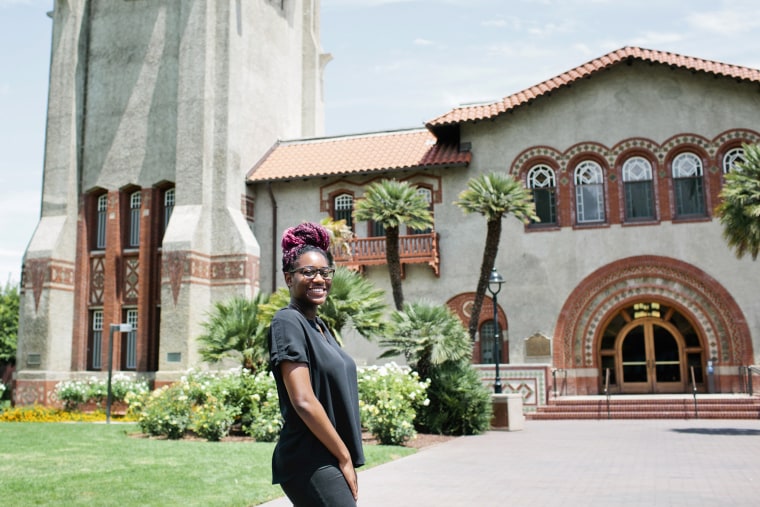This article about California higher education was produced by CalMatters, a nonprofit, nonpartisan California policy news site, and The Hechinger Report, a nonprofit, independent news organization focused on inequality and innovation in education.
SAN JOSE, Calif. — Jaelyn Deas and her four best friends shared everything, including late-night study sessions in the library at San Jose State University and a never-ending preoccupation over how they would pay for tuition.
The one thing they didn’t do together? Graduate.
While she was juggling a major in international business, a minor in Japanese and a job to help keep up with her expenses, Deas fell behind in class, and her friends put on their caps and gowns and walked across the stage in May without her.
It was they who were defying the odds. Fewer than 20 percent of Deas’ classmates who entered San Jose State in 2014 finished in four years — less than half the national average.
That didn’t make Deas feel any better. She considered quitting or transferring to a community college. Then she was summoned to the financial aid office, where she learned that the university, part of the California State University System, was giving her a grant of up to $1,500 to help her get across the finish line.
“I walked out of the office crying. I had no idea something like this existed, and it took a burden off my shoulders,” said Deas, who is on track to earn her bachelor’s degree before the year is out.
It’s one example of the many ways that California is taking on seemingly intractable problems that are also plaguing higher education nationwide.
These include the longer-than-expected time it takes students to graduate; high dropout rates; financial aid that doesn’t cover living expenses; courses that cost more than students will earn upon graduation; institutions that prey on veterans and others; financial aid applications so complex that many students never bother with them; admissions policies that favor relatives of donors and alumni; credits that won’t transfer; pricey textbooks; and “remedial” education requirements that force students to retake subjects they should have learned in high school, often frustrating them enough to quit.
To tackle these problems, California is trying creative solutions. Among other initiatives, the state this year has invested heavily in helping community college students transfer to four-year schools; spent $50 million on campus food banks and other programs to combat student hunger and homelessness; opened an online community college to serve students who are working; and boosted state grants for students with children.

In funding these programs, California is bucking a national trend as most other states continue to reduce, not increase, their investment in higher education. With a higher education budget of $18.5 billion in 2019-2020, California is one of just four states spending more on higher education, per student, than they did in 2008, according to the Center on Budget and Policy Priorities, a liberal-leaning think tank.
Not all of California’s higher education proposals have succeeded. Nor is California the only state trying them, often in the absence of reforms at the federal level. That program at San Jose State to help students make it to graduation by offering them small bursts of financial aid, for instance, was pioneered at Georgia State University.
But California’s decisions can have a national impact. After it took on the NCAA in September by requiring that college athletes be allowed to sign paid endorsement deals, for example, legislators in New York, Florida, Minnesota, Nevada, Ohio, Pennsylvania and South Carolina started mulling comparable legislation. That prompted the NCAA to let college athletes benefit from the use of their names and likenesses, though the association is still working out the details.
Fueling California’s changes and proposed changes — and the funding behind them — is a projected shortage of workers with the necessary degrees to fill jobs in fields such as business operations, computer science and health care. The investments have also been driven by a backlash to budget cuts made during the recession, and a concern that the state — whose public colleges alone include 10 University of California (UC) campuses, 23 California State University (CSU) campuses and 115 community colleges — is losing its long tradition of high-quality, low-cost education.
Californians remember “when younger generations could truly expect to live a better life than their parents and grandparents. And that dream has been fading,” said David Chiu, a member of the State Assembly from San Francisco who is active in education issues.
“That’s why so many of us have been focused on how do we bring this back,” Chiu said. “Because we had that history, because we knew what a well-functioning higher education system could do, we aspire to that again.”
California’s challenge
Over the course of a century, California built the country’s most prestigious public research university and its largest and most affordable community college system.
A California resident in 1960 could earn a bachelor’s degree at the world-class University of California, or UC, for just $60 per semester in “incidental fees” — about $500 in today’s currency. That same year, the state adopted a master plan for higher education: The UC would serve the top one-eighth of graduating high school seniors while the top one-third would be eligible to attend a CSU campus, and the community colleges would be open to all.
The goal, writes historian John Aubrey Douglass, was “broad access combined with the development of high quality, mission differentiated, and affordable higher education institutions.”
But in the coming decades, politicians of both parties would respond to economic downturns by cutting higher education funding, causing tuition to rise. The trend peaked during the recession that began in 2008, when UC hiked undergraduate fees by nearly a third in a single year.
Related: As college enrollment falls, recruiters descend on a state that still has lots of applicants
According to the independent California Budget and Policy Center, the price of undergraduate tuition and fees, when adjusted for inflation, has increased sixfold in the last 40 years at the University of California and is 15 times higher at California State campuses. Barely one student in 10 graduates in four years at Cal State Los Angeles, East Bay, Sacramento or Dominguez Hills.
The upshot? Fewer than half of adults in California have college degrees or certificates, which is short of a state target of 60 percent by 2030 set by the Campaign for College Opportunity, an advocacy group.
“That number gets a lot of play across the street,” said Jake Jackson, a Sacramento-based research fellow at the Public Policy Institute of California, a nonpartisan think tank, gesturing toward the state Capitol.
At the same time, California’s student population has become more ethnically diverse, with growing numbers coming from low-income families in which they are the first to go to college. No racial or ethnic group constitutes a majority here: Thirty-nine percent of residents are Hispanic, 38 percent are white, 14 percent are Asian and 6 percent are black. More than a quarter are immigrants.
Related: The soul-crushing cost of college, explained
Cristina Mora remembers feeling lost and adrift after leaving her close-knit Latino neighborhood in Los Angeles to enroll at Berkeley in 1999 — “like there had been a clerical error, and I’d been admitted by mistake.” She didn’t take advantage of a professor’s office hours until her junior year, finally converting the Cs and Ds she’d been earning into A-pluses.
Today, Mora is an associate professor of sociology at Berkeley and a mentor to other first-generation college students. She says UC has made strides in attracting diverse applicants by increasing recruiting in previously ignored areas such as the Central Valley and towns along the Mexican border and making it easier for community college students to transfer. Students of Mora’s generation returned to their communities, she said, bringing with them “a sense that the UC system provides an opportunity and that these are places that would be welcoming.”
But black and Latino students still are less likely than their peers to graduate from UC or CSU institutions in four years and are underrepresented on the state’s most selective campuses. Among UC students, they take on higher-than-average levels of debt.
“We have a long history of not catering to these populations,” Mora said.
Related: Some colleges seek radical solutions to survive
If policymakers are going to close California’s graduation gap, they’ll have to figure out how to meet the needs of students like Mora and Deas. And if California can do that, perhaps the rest of the country can, too.
Helping students graduate
California has used its vast power of the purse to increase the number of transfer students — especially from the state’s community colleges — accepted by both public and private universities.
Nationwide, students who transfer lose more than 40 percent of the credits they’ve already earned and paid for, according to the federal Government Accountability Office, wasting huge amounts of time and money.
Then-Gov. Jerry Brown threatened in 2017 to withhold a $50 million allocation to the UC system unless it increased its share of transfer students, and to strip private colleges and universities of their eligibility for the $2 billion Cal Grant program unless they did a better job of admitting transfers.
Brown wanted some public universities with low numbers of transfers to take one transfer student for every two freshmen, a goal they’ve largely met. The private, nonprofit member institutions of the Association of Independent California Colleges and Universities have agreed to collectively take 3,000 transfer students annually by next year.
The state invested $75 million last year to try to raise those low CSU graduation rates, and plans to spend another $75 million this year. The rates have slowly started to improve, with 27.7 percent of CSU students finishing in four years, up from 19 percent in 2015. (The national average is 42 percent.)
Some of that extra money has gone to hire advisers and add sections of courses that were filling up too fast. Not getting into the classes he needs is still the fear of James Soberano, a San Jose State freshman majoring in computer engineering, who was pecking away at his laptop in the student center.
“I definitely want to be out of here in four years,” Soberano said.

The completion grant that Deas got is part of a program that began last year for seniors who are within two semesters of earning their degrees and meet other requirements. They can receive up to $1,500 per semester. Seventy percent of recipients have graduated, the university says.
Related: Questioning their fairness, a record number of colleges stop requiring the SAT and ACT
Another effective way of speeding students up is by eliminating noncredit remedial courses, which require them to repeat subjects such as algebra and English. More than four in 10 college students across the country end up in remedial — also called “developmental” — classes. That costs an estimated $1.3 billion a year, and many students steered into them simply give up.
In California, 80 percent of community college students were previously sent to remedial courses in English or math, and only 16 percent of them earned a certificate or associate degree within six years, according to the Public Policy Institute of California.
Since 2017, however, California’s community colleges have instead begun putting less-well-prepared students into credit-bearing introductory courses with extra tutoring. The CSU system, too, started doing this last year, and also funnels students with low high school grades or standardized test scores into special preparation programs in the summer before their freshman year.
Though some faculty have objected to the changes,early studies suggest they’ve led to big improvements. Sixty-three percent of community college students who were put directly into transfer-level English composition courses with tutoring successfully completed them, compared to 32 percent who were first sent to remediation.
Costs outside the classroom
Bright murals decorate the walls of UC Berkeley’s Basic Needs Center, framing the entrance to a food pantry laden with organic mac and cheese, fresh produce and bread from the nearby Acme Bakery.
Students who have trouble affording food and rent come here to do their grocery shopping, sign up for public benefits or meet with counselors. A community kitchen is under construction, and volunteers use a custom tricycle to pedal around nearby neighborhoods collecting excess produce from residents’ gardens.
The center is the result of student activism spotlighting the nontuition costs of college in a state where the price of housing has soared. The goal: to ease students’ stress about food and shelter so they can focus on their studies.
California students spend an average of $2,020 a month, or $18,180 per nine-month academic year, on food, housing, books, supplies and transportation, a survey released in September by the California Student Aid Commission found.
Related: Should community colleges build housing?
California is well positioned to address college affordability because unlike in many other states, every low-income student who has completed high school within the previous year and meets academic requirements is entitled to a state scholarship, the Cal Grant, that helps pay their tuition.
While hundreds of thousands still miss out on the grants each year because they took time off before college, this relatively generous tuition aid has nevertheless freed policymakers to think about how to make the other aspects of college more affordable, said Lande Ajose, senior policy adviser on higher education to Gov. Gavin Newsom.
“For six of the last seven years, tuition has remained flat at our colleges, and yet we find the cost of college increasing, and that is because the cost of living is increasing,” Ajose said.

California has thrown a lot of other ideas at making college more affordable. The California State system and some UC campuses have substituted cheaper digital books and open-source materials for textbooks, for example.
And the California Student Aid Commission last year began to simplify the complex process of applying for financial aid, which research shows makes prospective students less likely to complete the process and enroll in college in the first place, by creating a user-friendly website and making it easier to compare the costs of different schools.
Campuses are opening food pantries like the one at UC Berkeley, holding outreach fairs to sign students up for the state’s version of the federal food stamp program and starting emergency housing programs, all backed by more than $50 million in this year’s state budget set aside to combat student hunger and homelessness.
Those funds came after students packed legislative hearings over the past two years to testify about rising rents and piling 30-hour work weeks on top of their study time. That kind of activism also stands out from what is happening in most other states, where students lack strong statewide organizations or are less involved in state politics, said Max Lubin, an Education Department official in the Obama administration who started the advocacy group Rise while a graduate student at Berkeley. The group provides paid fellowships for students to spend a semester lobbying on college costs.
“California higher education leaders have learned in the last couple of years that they can get a lot more done by working with students than in conflict with them,” Lubin said.
The state has taken steps to help older students, too.
Newsom successfully pushed this year to provide students at public universities and colleges who are parents of dependent children with as much as $6,000 a year for books, child care and other nontuition expenses on top of tuition aid. An estimated 29,000 parents qualify, the governor’s office says. In September, the state debuted an online community college designed especially for people 25 to 34 who are already working but don’t have a college degree or certificate.
California has also begun to tighten regulation of for-profit colleges and universities, which often serve older, low-income students. While the most stringent proposals to crack down on for-profit schools have stalled, thanks in part to aggressive lobbying by the industry, the state will begin to collect information on graduates’ income and debt, by institution, so consumers can make better-informed choices about which programs will pay off.
Experiments are spreading
California is not the only state trying to improve student outcomes, or to make policy in the absence of federal action. Amid the partisan bickering in Washington, the Higher Education Act, which covers all federal regulations over higher education and which Congress typically reauthorizes every four to six years, hasn’t been updated since 2008.
Louisiana last year started to require high school seniors to complete the Free Application for Federal Student Aid. Texas will also require this, beginning in 2021-22. Thirty percent of undergraduates never fill out this form, forgoing the chance to receive financial aid; 30 percent of them would have qualified for a federal Pell Grant, research supported by the American Academy of Arts and Sciences found.
Colorado is dropping remedial courses, too, beginning in 2022, and universities and colleges there have already started getting rid of them.
Many states have resorted to enforcement actions, lawsuits and new laws to crack down on for-profit colleges and universities and loan-servicing companies they say cheat or mislead students as the Trump administration softens federal regulations that were beefed up during the Obama years.
And at the federal level, a House bill — introduced by Rep. Adam Schiff, D-Calif. — would create a pilot program to help community colleges pay for free meals for students.
But few other states are trying as many experiments at once as California, or can do so at such scale. California’s size will continue to make it a laboratory for innovation, Kevin Cook, a researcher at the Public Policy Institute of California, said.
“If you can make something work here, it will probably work anywhere else,” he said.
